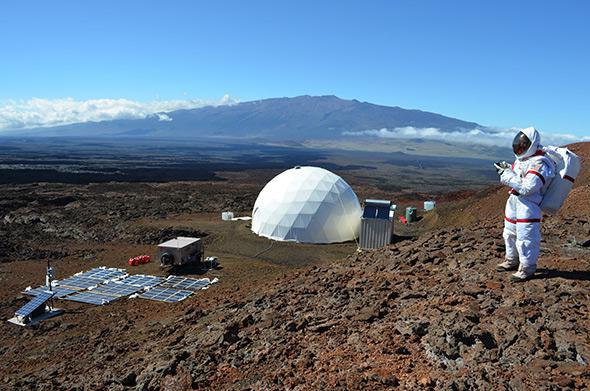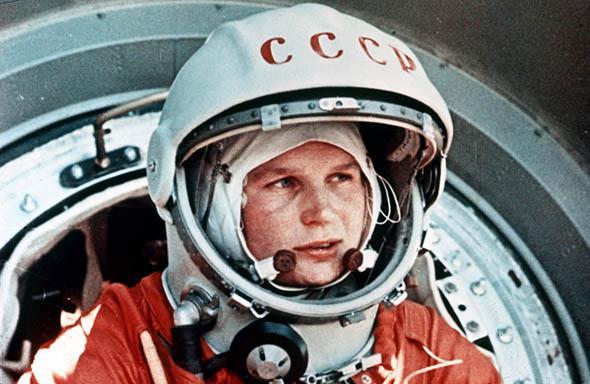In February of 1960, the American magazine Look ran a cover story that asked, “Should a Girl Be First in Space?” It was a sensational headline representing an audacious idea at the time. And as we all know, the proposal fell short. In 1961, NASA sent Alan Shepard above the stratosphere, followed by dozens of other spacemen over the next two decades. Only in 1983 did Sally Ride become America’s first female astronaut to launch.
But why would anyone think a woman would be the first to space, anyway? Medical studies, for one thing. Some studies in the 1950s and ’60s suggested female bodies had stronger hearts and could better withstand vibrations and radiation exposure. Moreover, psychological studies suggested that women coped better than men in isolation and when deprived of sensory inputs.
Some of these investigations were limited in their design and sample sizes. But there was another, more compelling reason that women might outshine men as potential astronauts: basic economics. Thanks to their size, women are, on average, cheaper to launch and fly than men. As a NASA guinea pig, I had the chance to verify this firsthand.
Last year I took part in a NASA-funded research project called HI-SEAS (Hawaii Space Exploration Analog and Simulation). It required that I and five other crewmembers live as astronauts on the surface of Mars. We didn’t leave Earth, obviously, but for four months we were cooped up in a geodesic dome on the side of the very red, very rocky, very Mars-like Mauna Loa volcano in Hawaii. Our food, water, power, and communications were limited, and we were only allowed to exit the habitat if we wore mock spacesuits. So many Martian hassles, so little glory.

Courtesy of Sian Proctor
This was the first HI-SEAS mission—a third starts this month—and it was designed mainly to study the types of food Mars explorers might eat. I was the crew writer, blogging for Discover and the Economist, and since I had the scientific background and interest, I conducted a sleep study, too.
I collected and managed the crew’s sleep data over the course of the experiment. One device we used to track sleep was the sensor armband from BodyMedia, which also provides estimates of daily and weekly caloric expenditure. While I didn’t know which data belonged to which subject due to anonymity requirements, I could see each subject’s sex. Over time I noticed a trend.
Week in and week out, the three female crew members expended less than half the calories of the three male crew members. Less than half! We were all exercising roughly the same amount—at least 45 minutes a day for five consecutive days a week—but our metabolic furnaces were calibrated in radically different ways.
During one week, the most metabolically active male burned an average of 3,450 calories per day, while the least metabolically active female expended 1,475 calories per day. It was rare for a woman on crew to burn 2,000 calories in a day and common for male crew members to exceed 3,000.
The data certainly fit with my other observations. At mealtime, the women took smaller portions than the men, who often went back for seconds. One crew member complained how hard it was to maintain his weight, despite all the calories he was taking in.
The calorie requirements of an astronaut matter significantly when planning a mission. The more food a person needs to maintain her weight on a long space journey, the more food should launch with her. The more food launched, the heavier the payload. The heavier the payload, the more fuel required to blast it into orbit and beyond. The more fuel required, the heavier the rocket becomes, which it in turn requires more fuel to launch.
Every pound counts on the way to space. NASA was keenly aware of this, and that’s why in the early 1960s it nearly considered a female astronaut corps. Of course, politics and culture have a pesky way of sneaking into engineering decisions, especially when a country’s pride is on the line, according to Margaret A. Weitekamp, author of Right Stuff, Wrong Sex: America’s First Women in Space Program. Despite extensive training and excellent performance, the women in the program were dismissed. Some of the reasons included fears about public relations if female astronauts were killed, as well as NASA’s reliance on military pilots, who at the time were only male.
The first woman in space was cosmonaut Valentina Tereshkova of the Soviet Union, who flew 20 years before Sally Ride. Her flight bolstered the appearance of communist egalitarianism during the Cold War. Russia hasn’t kept up a female presence in orbit, though; it only just last month launched its first female cosmonaut in almost two decades, Elena Serova.

Photo by Sovfoto/UIG via Getty Images
Back to Mars. According to Robert Zubrin, aerospace engineer, author, and president of the Mars Society, a round-trip mission to Mars could cost as little as $30 billion. While this is a low-ball estimate that ignores many of the details, it suggests that a manned Mars mission might not cost $450 billion, an amount proposed by NASA in 1989 that many believe is close to the upper limit for such a mission. Many of today’s estimates tend to be around $100 billion.
To put these price tags in perspective, the Curiosity rover cost $2.5 billion. And while Curiosity is an impressive feat of engineering that is collecting and analyzing more of Mars than any robot before, its capabilities as an explorer pale in comparison to that of a human crew. In mere hours, a trained geologist could spot a rock that fills in gaps of solar system formation theory. Such a significant discovery could take a rover weeks, months, or years, if ever. Admittedly, though, rovers also have the benefit of running on plutonium dioxide and never needing to defecate. A manned Mars mission requires designing for the burdens of having a body.

Photo by Apic/Getty Images
In the early 2000s, Alan Drysdale, a systems analyst in advanced life support and a contractor with NASA, was thinking about the problem of astronaut bodies. He turned to a NASA document on physiological metrics called STD-3000, Man-Systems Integration Standards (now revised to STD-3001), which details needs and effluents for a range of body types. The STD-3000 gave the stats for women whose size was in the fifth percentile to men sized in the 95th percentile, a range from about 4-foot-11 and 90 pounds to 6-foot-3 and 215 pounds. He crunched the numbers.
Drysdale found that a fifth-percentile woman would use less than half the resources of a 95th-percentile man. While we didn’t have a woman on the HI-SEAS crew who was in the fifth percentile, our stats were similar to the predictions.
Drysdale, who no longer works with NASA, is emphatic that the space agency wastes money and doesn’t consider cost-saving approaches like a Mars crew of smaller astronauts. He says his calculations suggest all things being equal, such a crew would launch for half the payload cost. “Small women haven’t been demonstrated to be appreciably dumber than big women or big men, so there’s no reason to choose larger people for a flight crew when it’s brain power you want,” says Drysdale. “The logical thing to do is to fly small women.”
Harry Jones, of NASA Ames Research Center, says that he too noticed the average female and male calorie requirement differed significantly and published on the topic in the early 2000s. “For a Mars mission, life support will be a major cost,” he says. “It is expected that oxygen and water can be recycled, but not food. Reducing the crew’s calorie requirement would cut cost.”
Indeed, a number of people I talked to acknowledged the benefits of an all-female crew, or even just a crew made of smaller people in general. One proponent is Andrew Rader, a mission integrator at SpaceX. “Anything to reduce weight and even in terms of making the spacecraft seem bigger, having smaller astronauts would be great,” he says, noting that he isn’t speaking on behalf of his company. “I think it’s a reasonable proposal.”
As reasonable as an all-female Mars mission is from an economic perspective, some might find the idea offensive. After all, it’d be an expedition that fails to represent half the world’s population; an all-female Mars crew would strike many as exceptionally biased.
Then again, space-mission design has always been biased in one way or another. Exploration in general is nothing if not political, dictated by the people with the money and power to choose the face of the expedition. Right now, it’s unlikely that those with the power to do so would agree to fund a crew of small female astronauts even to save money.
And at this stage of predesign research for Mars, many who work with NASA believe selecting the right people for a mission is more nuanced than simply calculating size and resource requirements. “It’s not really politically correct to mention that size, body type, gender, intelligence, agility, emotional structure, education, and other individual differences might all affect the cost-benefit equation in astronaut selection,” says Jones. “Really, the issues are all about crew performance including group dynamics, individual psychology, etc.”
Crew cohesion was an important subject of study during the HI-SEAS mission last year. My six crew members and I were chosen out of 700 applicants worldwide. We were a relatively diverse bunch: a Belgian man, a Canadian man, a Russian-American man, a Puerto Rican woman, a black woman who grew up in the Northeast, and me, a white woman from Kansas. We had a range of engineering, science, and creative backgrounds. For half of us, English wasn’t our first language.
Because of our differences, we were often learning and relearning each other’s problem-solving approaches, personalities, language quirks, and food preferences. But soon we realized that our diversity helped us solve various problems that came up, from designing new scientific experiments and analyzing data to building equipment to finding ingredient substitutions for recipes.
This was also the experience of astronaut So-yeon Yi, South Korea’s first and only astronaut, who flew to the International Space Station in 2008. On being in a diverse group, she told me: “At first it’s hell, but in the long term, diversity is very good. It’s because uniform people in a team may be comfortable, but they can’t know what they don’t know.”
Soyeon Yi, who is 5-foot-4, said she didn’t feel as cramped in the space station as the cosmonauts who were more than 6 feet tall. They were envious of her freedom of movement, she said. But she also stressed that she’d rather be in a diverse group than one that’s too similar.
Based on my HI-SEAS experience, I tend to agree. Still, if the bottom line is what matters in getting to Mars, the more women the better.
